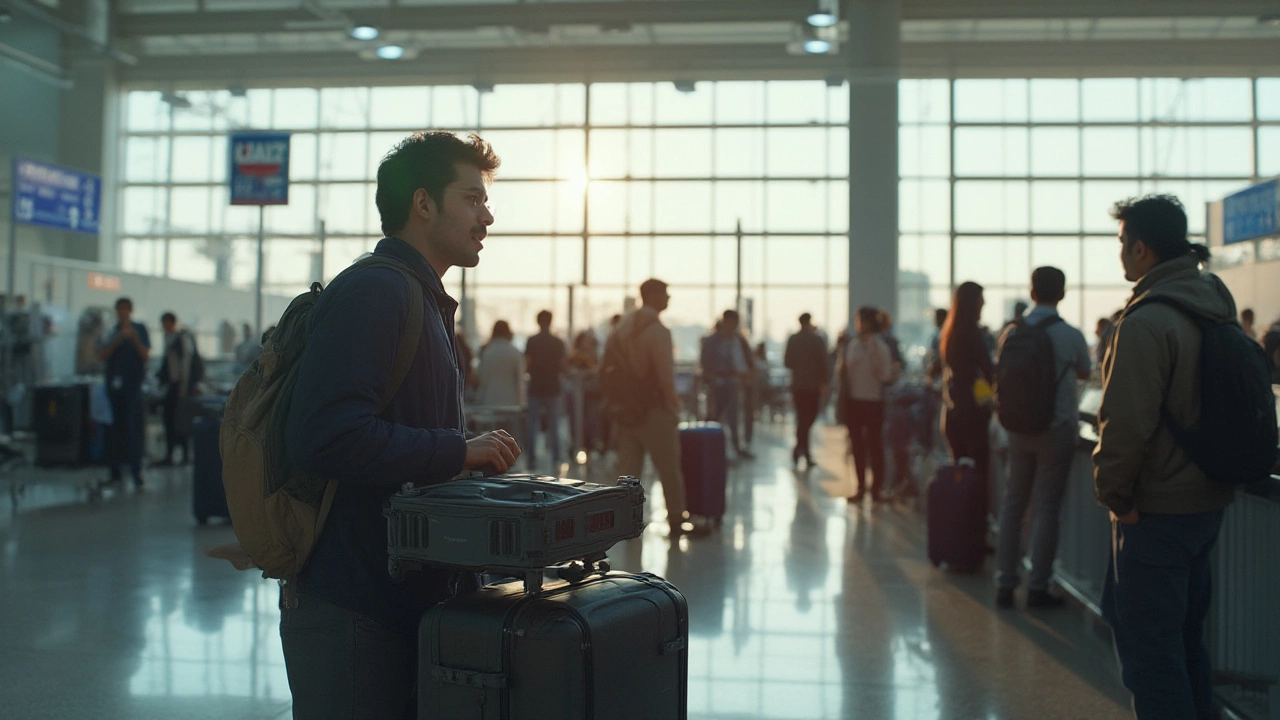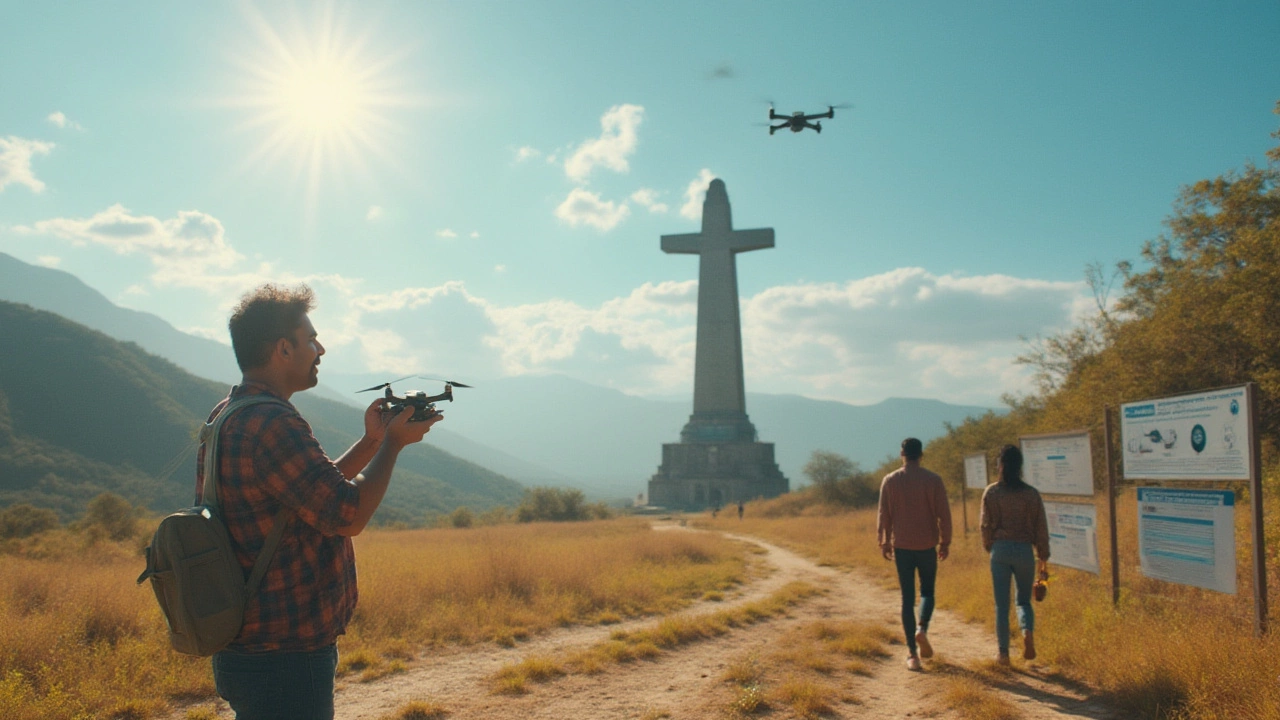Bringing a Drone to the USA: Rules, Tips, and What You Need to Know
 Jul, 18 2025
Jul, 18 2025
When you’re itching to capture big-city skylines or wilderness shots in the States, there’s nothing quite like flying your own drone. But showing up at the airport with your quadcopter isn’t as simple as packing sneakers and a camera. The USA is wild about drones—nearly 870,000 drones are registered with the FAA as of 2025, so expect detailed rules. Forgetting even one form or battery tip can freeze your plans faster than a New York winter. Let’s clear up who can bring in a drone, what it takes to get it through customs, and how to avoid those stories of grounded drones–or worse, confiscated gear.
Can You Legally Bring a Drone to the USA?
Bringing a drone into the United States is allowed, but it’s not the kind of thing you want to improvise. US Customs and Border Protection (CBP) officers see hobby drones all the time—sometimes hundreds a week at big airports like JFK or LAX. The catch? The rules change depending on whether you’re entering as a tourist, business visitor, or resident. If you’re coming in as a traveler, you don’t need a special import license for a retail drone, but you do need to comply with US drone regulations right after touchdown.
Most major drone brands—DJI, Autel, Skydio, and Parrot—are approved for US entry. Rare exceptions exist, like drones with high-powered transmitters that can interfere with US networks—these may get flagged by customs. If your drone’s transmitter is FCC certified (you’ll see a small label on the drone or in its paperwork), you’re usually clear.
CBP officers might ask why you’re carrying a drone. Never say it’s for commercial filming unless you mean it—if you declare commercial intent, customs officers could ask for proof of your business or USCIS work permissions. For pure hobbyists, say you’re flying for fun, and have proof of return travel ready. If the drone was expensive (over $2,500), be prepared to show a purchase receipt; anything over that value might need to be declared and could be taxed.
The one thing that will snag you? Batteries. US rules strictly control lithium-ion batteries. Carry-on only (don’t check large batteries!), and each battery must be under 100Wh. If you’ve got pro-level batteries between 100–160Wh, you can bring up to two. Anything larger—you’re out of luck. Wrap your batteries in fireproof bags and cover their terminals. TSA screens for these, and you don’t want a meltdown literally or figuratively.
- All drones over 0.55 lbs (250 grams) must be registered with the FAA if you plan to fly them in the US.
- Never pack lithium-ion drone batteries in checked luggage—always bring them in your carry-on.
- Customs will want to see undeclared items if you look like you’re planning to sell on eBay, so keep it to personal use.
- Rarely, drones with certain wireless tech (mainly older long-range FPVs) are prohibited by the FCC.
- No need for special US import forms for typical consumer drones—they’re classified as personal electronics.
Curious how often drones are seized? In 2024, CBP reports just under 350 cases of drone-related detentions at entry points—almost half due to commercial misrepresentation or excessive battery packs.
| Year | Drone Imports Declared | Batteries Seized | Drone Detentions by Customs |
|---|---|---|---|
| 2022 | ~240,000 | 56 | 290 |
| 2023 | ~312,000 | 79 | 325 |
| 2024 | ~385,000 | 93 | 347 |

Clearing the Airport: TSA and Airline Tips for Drone Travelers
The moment airport security sees your drone case, it’s X-ray time. Flying with drones is mainstream now, but you can’t count on every TSA officer knowing the specs of your drone or how to spot safe batteries. If you want a smooth experience, have the drone out, batteries packed safely, and paperwork handy. Print out FAA rules if you’re the belt-and-suspenders type—sometimes it helps when agents are uncertain.
A lot of travelers miss this: your drone must go in your carry-on. Airlines almost all ban checking drones, since batteries can flame out. Don’t trust airline websites—they sometimes skip the details. Each battery should be in a fireproof sleeve or strong zip-lock, with terminals taped or covered. Drones with camera gimbals? Secure those with shipping foam or a gimbal lock—you don’t want it to jiggle and break in turbulence.
TSA’s own guidelines say you can bring drones as long as you present them for inspection. But rules about battery watt-hours and quantity come from the FAA and the airlines themselves. Here’s what works in 2025:
- Each battery must be under 100Wh for unlimited pieces; between 100-160Wh, only two extra batteries allowed.
- Always remove batteries from the drone before screening.
- Your charger cables should be bundled—loose wires mean slow inspections.
- Manuals: bring them, physical or digital. Security sometimes likes seeing product info.
- If you’re stopped at security, explain what the drone is for and be chill—most questions focus on batteries, not the drone itself.
If you’re traveling with non-detachable batteries (Mavic Minis, Airs), point out the built-in design. TSA screens for lithium content, sometimes going so far as to swab the casing for trace chemicals if batteries look modified. Don’t argue—answer their questions, and you should pass in less than five minutes.
A lot of folks want to bring huge drone kits, but bigger is not better at airports. Don’t stress-test TSA’s patience: three batteries, max, and a mid-size drone get waved through the fastest. Bonus points if you pack a printed airline policy sheet with you—sometimes gate agents check those instead of looking up the airline database.
Pro tip: If you get randomly flagged for secondary screening, mention you’re an enthusiast and share some sample drone photos (if you have them on your phone). Most TSA agents are curious about good aerial shots, and making the conversation personal goes a long way.

What Happens After You Land? Registering, Flying, and Avoiding Trouble
Here’s where the real work begins. The second you’re in the USA, your imported drone becomes official business for the Federal Aviation Administration (FAA). Anything above 0.55 lbs (250 grams)—that’s nearly all camera drones except the tiniest ones—must be registered. For visiting tourists, the process is quick: head to the FAA Drone Zone site, pay $5, and slap your reg number somewhere on the hull. You’ll need proof of registration on hand (digital or printed) when flying.
But that’s not all. The US takes flying rules seriously. If you’re caught flying illegally near an airport, stadium, or over people without waivers, fines can reach $27,500. In 2023, the FAA issued 201 drone-related fines, with the top reasons being unregistered devices, reckless flights, and no-remote ID. Since September 2023, all drones requiring registration also need Remote ID, which means your drone must broadcast its serial, operator, and location anytime it’s airborne in US airspace. If your model doesn’t have Remote ID built-in, you need a separate module (these cost around $120 as of 2025). Don’t risk it—agents have started doing random park and event checks.
Do you need a US drone license? As a visiting tourist, not for hobby flights. But if you plan to sell drone shots, take footage for work, or even do paid social media content, you’ll need FAA Part 107 certification. It’s a US-only test, but you can prep in advance and take the exam once you land—it’s not impossible, but expect to spend up to $175 for testing fees and a few hours on study materials.
- Always check for local ordinances: Some cities (like New York, LA, and Washington DC) have strict no-drone zones besides FAA rules.
- Flying in National Parks? It’s a hard no—US National Park Service bans all drone flights over park land. If you risk it, rangers can seize your drone and fine you on the spot.
- Drone insurance isn’t required, but smart. A single drone crash can rack up thousands in liability if you hit a car or person. Travelers can grab month-long insurance for $35-60 online.
- Always pack your drone registration, Remote ID proof, and drone receipt—law enforcement can ask for these anywhere you fly.
- Desert, coastal, and mountain zones in the US offer amazing footage once you clear the legal hurdles. Moab’s red canyons, Alaska’s glaciers, and Florida’s Everglades are favorite shooting spots for visiting pilots.
One cool fact—after the 2023 Super Bowl drone show, US Customs actually reported a spike in foreign drone registrations in Arizona and Nevada. So, you’re not alone if you’re flying in for a big event or festival, but do your homework. Flying over crowds, stadiums, government buildings, or military bases is a guaranteed way to get in trouble. Stick to wide-open spaces and always check B4UFLY, the FAA’s free app, for restricted zones before takeoff. It's where most hobbyists get tripped up—airspace restrictions change daily depending on events and weather.
If you ever lose your drone or it gets confiscated by US authorities, keep receipts and proof of ownership handy. Sometimes you can appeal for return (if it was a paperwork issue and not a safety violation). But drones lost because of illegal filming or reckless flying almost never come back.
So, can you bring your drone to the US? Absolutely, if you plan ahead. Remember: registered, Remote ID enabled, batteries safe, and always check local laws where you land. Safe flying, and maybe I’ll see your footage in the next viral drone compilation from America’s wildest places.